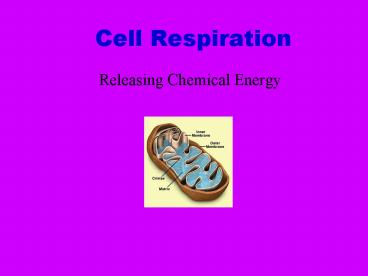Cell Respiration - PowerPoint PPT Presentation
1 / 23
Title:
Cell Respiration
Description:
... Respiration occurs in the mitochondria- an organelle in the cytoplasm ... This free energy is used to move protons into the matrix of the mitochondria. ... – PowerPoint PPT presentation
Number of Views:45
Avg rating:3.0/5.0
Title: Cell Respiration
1
Cell Respiration
- Releasing Chemical Energy
2
Introduction
- All organisms must have energy to carry out life
processes. - Where does this energy come from?
Autotrophs collect energy from the sun and store
it as organic compounds.
3
The Need for Energy
- No Energy no work
- Energy Work
4
Respiration An Overview
- Metabolism is all of the chemical reactions in
the body. - These reactions are either
- Synthesis combining small molecules to make
complex molecules OR - Decomposition reactions breaking down molecules
into simpler forms.
5
Reactions Continued
- Synthesis reactions require energy example
photosynthesis. - Decomposition reactions release energy.
- This energy can be used to make ATP
- ATP is a small, useable packet of energy.
6
Cellular Respiration
- Cell Respiration is a decomposition reaction that
provides the energy cells need to function. - In this series of reactions, sugars, proteins,
and lipids are broken down (decomposed) and
energy is released.
7
Types of Cellular Respiration
- There are two types of cell respiration aerobic
and anaerobic. - Aerobic respiration occurs in the presence of
oxygen.
2. Anaerobic respiration occurs in the absence of
oxygen.
8
Raw Materials for Cell Respiration
- What are the raw materials for cell respiration?
Carbohydrates, proteins, and lipids
9
- How does the food become the raw materials?
- Food is digested into carbohydrates, lipids, and
proteins.
10
Glucose and Glycogen
- Glucose is the form in which animals transport
carbohydrates through the blood stream.
- Glycogen is the form in which it is stored in
animals. - Glycogen is stored in the liver and muscles.
11
Mitochondria
- Mitochondria are the energy factories of the
cells.
12
Mitochondria
- Cellular Respiration occurs in the mitochondria-
an organelle in the cytoplasm of cells. - They have
- an outer membrane that encloses the entire
structure - an inner membrane that encloses a fluid-filled
matrix - between the two is the intermembrane space
- the inner membrane is elaborately folded with
shelf-like cristae projecting into the matrix.
13
Stages of Cell Respiration
- Glycolysis
- Krebs Cycle
- Electron Transport System
14
Glycolysis
- Glycolysis happens in the cytoplasm.
- Glucose is split into 2 three-carbon molecules.
- Enzymes partially oxidize glucose and this
partial oxidation releases energy that forms a
small amount of ATP. - This is an anaerobic process and 2 net ATP are
generated. - This ATP is used to start the Krebs Cycle.
15
Glycolysis Animations
- http//www.science.smith.edu/departments/Biology/B
io231/glycolysis.html - http//instruct1.cit.cornell.edu/courses/biomi290/
ASM/glycolysis.dcr - http//science.nhmccd.edu/biol/glylysis/glylysis.h
tml - http//instruct1.cit.cornell.edu/Courses/biomi290/
MOVIES/GLYCOLYSIS.HTML
16
Krebs Cycle
- The Krebs cycle completes the decomposition and
oxidation of glucose to carbon dioxide. - The carbon dioxide is released as a gas.
- The oxidation of one glucose molecule yields up
to 38 ATP molecules under ideal conditions (this
occurs infrequently)
17
- The reaction of acetyl CoA with oxaloacetate
starts the cycle by producing citrate (citric
acid). - In each turn of the cycle, two molecules of CO2
are produced as waste products, plus three
molecules of NADH, one molecule of GTP, and one
molecule of FADH2. - The number of carbon atoms in each intermediate
is shown in a yellow box. (see picture next slide)
18
(No Transcript)
19
Krebs Cycle Animations
- http//www.science.smith.edu/departments/Biology/B
io231/krebs.html - http//www.wiley.com/legacy/college/boyer/04700037
90/animations/tca/tca.htm
20
The Electron Transport Chain
- It is composed of the mitochondrial enzymes that
transfer electrons from one complex to another,
eventually resulting in the formation of ATP. - In the first part, electrons are transferred from
protein to protein and energy is lost as free
energy along the way.
21
ATP Synthetase
- This free energy is used to move protons into the
matrix of the mitochondria. - As they pass through the matrix, they pass
through the ATP synthetase enzyme. - This causes a charge differential (gradient)
which drives the forming of ATP from ADP.
22
Electron Transport
- http//www.wiley.com/legacy/college/boyer/04700037
90/animations/electron_transport/electron_transpor
t.htm - http//www.science.smith.edu/departments/Biology/B
io231/etc.html - http//www.sp.uconn.edu/terry/images/anim/ETS.htm
l
23
ATP Synthesis
- http//telstar.ote.cmu.edu/biology/animation/ATPSy
nthesis/biochem.html - http//www.sp.uconn.edu/terry/images/anim/ATPmito
.html































